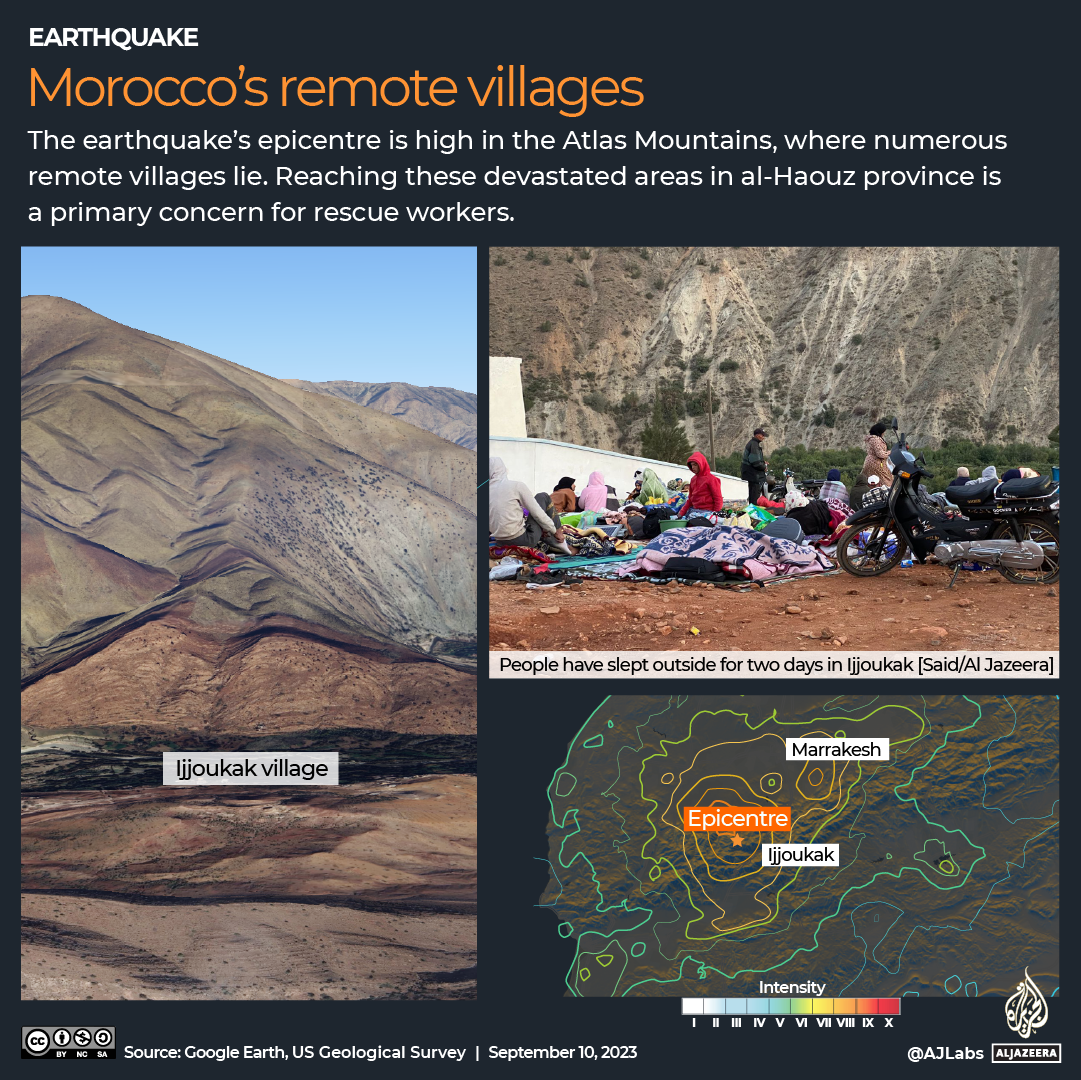
The magnitude 6.8 earthquake that struck Morocco late on Friday has killed more than 2,100 people, a death toll that is expected to increase as rescuers reach hard-hit remote mountain areas.
Here is what you need to know about the earthquake and the ongoing rescue operations:
When and where did the earthquake occur?
The earthquake hit after 11pm (22:00 GMT) on Friday evening, according to the United States Geological Survey (USGS).
It struck 72km (45 miles) southwest of Marrakesh, Morocco’s fourth largest city.
The epicentre was Ighil, a mountainous rural commune in Al-Haouz province near the Oukaimeden ski resort in the Atlas Mountains.
The quake was felt throughout the country, including in the provinces of Ouarzazate, Marrakesh, Azilal, Chichaoua and Taroudant.
Tremors were felt as far away as Huelva and Jaen in southern Spain.

What have residents of the worst-hit areas told Al Jazeera?
Al Jazeera spoke to residents of the mountain village of Tafeghaghte, which was almost entirely destroyed.
“Everyone is gone! My heart is broken. I am inconsolable,” cried Zahra Benbrik, 62, who said she had lost 18 relatives. Only the body of her brother remained trapped in the rubble.
“I want them to get him out so I can mourn in peace,” she said.
In Taalat N’Yaacoub, about 90km (56 miles) south of Marrakesh, efforts to find survivors trapped in the rubble continued. Mohamed Ait Ighral waited anxiously. Having already lost nine family members, he told Al Jazeera he hoped his remaining grandchild might be saved.
“It breaks my heart,” he said. “I lost my daughter. Her children are gone. [I’m] waiting for one. Let’s hope he is alive.”
By the time the boy was pulled from the rubble, he was dead.
He will be buried near his parents in the village cemetery.

How many people are affected?
The earthquake has killed 2,122 people and injured 2,421, many seriously, according to official figures, but numbers are expected to rise.
The United Nations estimated the disaster has affected 300,000 people.
Who has been most affected?
Of the 2,122 deaths reported as of Sunday evening, 1,351 were in Al-Haouz, a region with a population of more than 570,00, according to Morocco’s 2014 census.
“More than 18,000 families have been affected” by the quake in Al-Haouz, Moroccan public television reported. The largely agrarian province had been suffering record drought that had dried up rivers and lakes when the earthquake hit.
Villages of clay and mud brick buildings built into mountainsides have been destroyed.
In Marrakesh’s Old City, ancient buildings crumbled in the quake, blocking its narrow streets with debris.
Residents of many affected areas who lost their homes have been sleeping in the open, fearing aftershocks and further destruction.
How does this earthquake compare to previous ones in Morocco?
Earthquakes of this size in the region are uncommon but not unexpected, according to the USGS.
Since 1900, there have been nine magnitude 5 and stronger earthquakes within 500km (311 miles) of this event, none of which was more than magnitude 6.

A magnitude 6.8 quake is classified as “strong”.
Magnitudes are based on a logarithmic scale, meaning for each whole number increase on the scale, the strength increases 10-fold. So Friday’s earthquake was 10 times more powerful than the magnitude 5.8 quake of 1960.
What rescue operations are under way?
Morocco has deployed helicopters, ambulances, rescue crews and soldiers to the region to help assist with the emergency response.
The earthquake triggered rock slides that have blocked roads and made it hard for rescue teams to reach many affected mountainous areas.
Najia Amrani, the director of the National Centre for Blood Donation and Investigation, announced that 6,000 bags of blood were collected in a single day, thanks to large-scale campaigns initiated by regional blood donation centres and civil society associations.
Reporting from Marrakesh, Al Jazeera’s Nicolas Haque said people high in the Atlas Mountains have called on the people of Marrakesh to come and help them.
“All hands are on deck – not just the defence forces, the Moroccan forces, but also volunteers from Marrakesh going out there. … We heard of people walking 20 miles [32km] with water and food to reach those villages desperate for help,” he said.
What help is on its way from other countries?
In an interview with Al Jazeera, Farhan Haq, spokesperson for the UN secretary-general, said UN teams have arrived in Morocco and are assessing its needs.
The Red Cross Society of China will give the Moroccan Red Crescent $200,000 for emergency humanitarian assistance, Chinese state media reported.
A Qatari rescue group has arrived in Morocco with vehicles and equipment for search and rescue missions and humanitarian aid.
The Ministry of Interior accepted search and rescue-focused international aid from Spain, the United Arab Emirates and the United Kingdom.
French Foreign Minister Catherine Colonna announced 5 million euros ($5.4m) in aid for non-governmental organisations participating in relief operations.
Algeria, which broke off ties with Morocco in 2021 after escalating tensions focused on the disputed Western Sahara region, said it would open its airspace for humanitarian and medical flights.







